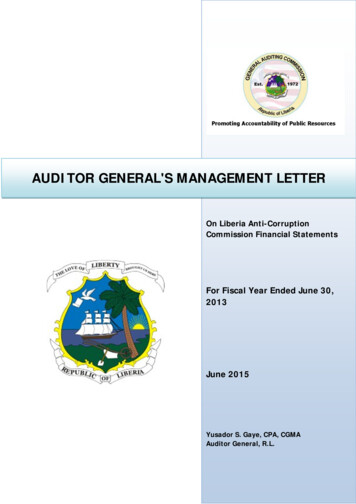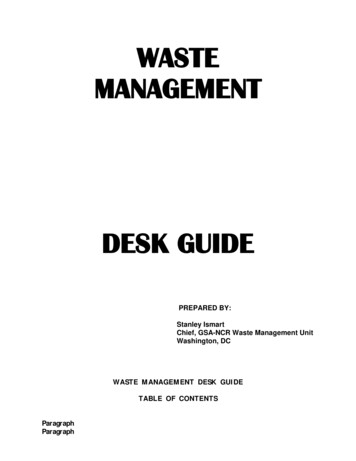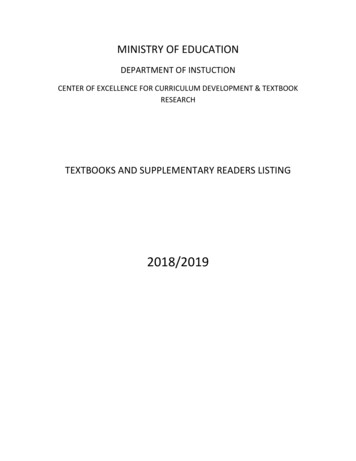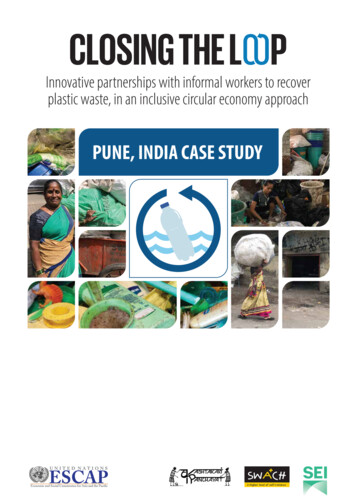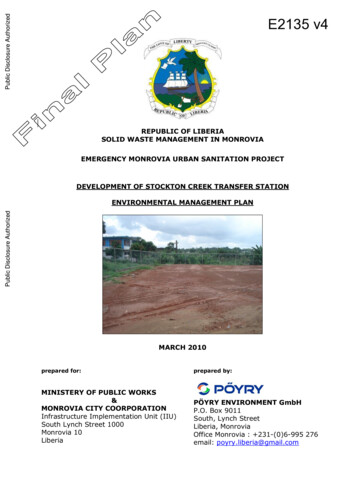
Transcription
Public Disclosure AuthorizedPublic Disclosure AuthorizedE2135 v4REPUBLIC OF LIBERIASOLID WASTE MANAGEMENT IN MONROVIAEMERGENCY MONROVIA URBAN SANITATION PROJECTDEVELOPMENT OF STOCKTON CREEK TRANSFER STATIONPublic Disclosure AuthorizedPublic Disclosure AuthorizedENVIRONMENTAL MANAGEMENT PLANMARCH 2010prepared for:prepared by:MINISTERY OF PUBLIC WORKS&MONROVIA CITY COORPORATIONInfrastructure Implementation Unit (IIU)South Lynch Street 1000Monrovia 10LiberiaPÖYRY ENVIRONMENT GmbHP.O. Box 9011South, Lynch StreetLiberia, MonroviaOffice Monrovia : 231-(0)6-995 276email: poyry.liberia@gmail.com
Republic of LiberiaEMUSDevelopment of Stockton Creek Waste Transfer StationEnviromental Management Plan (EMP)Table of Contents1.INTRODUCTION61.1Objectives of the Assignment61.1.1Specific Objectives61.1.2The Environmental Management Plan (EMP)61.2Institutional arrangements71.3Draft Environmental Policies and Laws82.HISTORICAL AND PROJECT BACKGROUND102.1Transfer Station development102.2Scope of Works102.3Operations philosophy113.NATURE OF THE PROJECT WITH REASONABLE ALTERNATIVES123.1Description of proposed actions and alternatives123.2Location of Stockton Creek Site124.CURRENT BASELINE CONDITIONS165.MAIN ACTIVITIES DURING SITE PREPARATION ANDCONSTRUCTION18GENERAL OPERATIONAL PROCEDURES OF THE SOLID WASTETRANSFER STATION196.1Description of the Transfer Station Facility196.2Design Capacity196.3Transfer Station Infrastructure206.3.1Community Access Point206.3.2Roof Structure206.3.3Offloading Bay206.3.4Loading Bay206.3.5Drainage System206.4Fencing and Gates216.5Office Block216.6Guard House216.7Integrated Facilities216.7.1Paving216.7.2Water Tank216.7.3Lighting System216.7.4Sewage Disposal226.Pöyry Environment GmbHMarch 2010ii P a g e
Republic of LiberiaEMUSDevelopment of Stockton Creek Waste Transfer StationEnviromental Management Plan (EMP)6.7.5Connecting Roads226.7.6Weigh bridge226.7.7Landscaping227.INSTITUTIONAL, STAFFING AND TRAINING REQUIREMENTS238.PUBLIC PARTICIPATION249.EXPECTED EFFECTS ON THE BIO-DIVERSITY, LAND AND WATER. 2510.ENVIRONMENTAL IMPACTS2610.1Introduction2610.2Positive impacts2810.3Negative impacts2811.SOCIAL IMPACT ASSESSMENT3211.1Introduction3211.2Relevant human environment – public involvement3211.3Identification of probable impacts (scoping)3211.4Environmental impacts3311.4.1 Noise and stress by heavy truck traffic3311.4.2 Odors generation (Air emissions, odors and dust)3311.4.3 Storm water drainage3311.4.4 Health and safety risks3311.4.5 Impact on landscape and visual intrusion3411.4.6 Description of further Impacts3411.5Investigation of probable impacts3511.6Determination of probable response3511.7Estimation of secondary and cumulative impacts3511.7.1 Recommendation of changes or alternatives3511.835Social Management Plan (SMP)11.8.1 Mitigation, remediation and enhancement plan3511.9Development and implementation of a monitoring plan3612.ADVERSE MITIGATION MEASURES AND MONITORING3712.1Introduction3712.1.1 Design and Preconstruction phase3712.1.2 Construction Phase3812.1.3 Operational phase4113.FACILITIES OPERATING PLAN4613.1Introduction4613.2General Operational Procedure46Pöyry Environment GmbHMarch 2010iii P a g e
Republic of LiberiaEMUSDevelopment of Stockton Creek Waste Transfer StationEnviromental Management Plan (EMP)13.2.1 Introduction4613.2.2 Transfer Station Procedures4613.2.3 Site Operation4714.OPERATIONS MONITORING PLAN5114.1Introduction5115.REPORTING PROCEDURES AND DOCUMENTATION5515.1Reporting5615.2Contingency ndix1.1:1.2:1.3:1.4:Water and Air Quality Monitoring at the SWTSList of DrawingsCapacity of the transfer stationMinutes of community consultation meetingList of FiguresFigure 1:Figure 2:Stockton Creek Transfer Station Location (Google image) .13Location of the site at Stockton Creek (Somali Drive to the North)(Google image) .13List of TableTable 1:Alternative Solution . 14Table 2:Baseline conditions at proposed transfer station site . 17Table 3:Environmental Impacts . 27Table 4:Summary of Positive Impacts for the Construction Stage . 28Table 3:Summary of Positive Impacts for the Operation Stage . 28Table 6:Summary of Negative Impacts for the Construction Stage . 29Table 7:Summary of Negative Impacts for the Operation Stage . 30Table 8:Table of persons met by Social Expert . 32Table 9:Potential local socio economic impacts at Stockton Creek transferstation . 34Table 10:Mitigation Measures Required in the Design and Preconstruction Phase. 37Table 11:Mitigation Measures Required During the Construction Phase . 38Table 12:Mitigation Measures to be audited during the Operational Stage . 41Table 13:Mitigation Measures to be monitored during the Operational Phase ofthe TS . 44Table 14:Monitoring Plan . 52Table 15:Summary of Documentation to Be Produced . 55Table 16:Estimated costs of EMP implementation and monitoring . 59Pöyry Environment GmbHMarch 2010iv P a g e
Republic of LiberiaEMUSDevelopment of Stockton Creek Waste Transfer StationEnviromental Management Plan (EMP)AbbreviationsBoQBill of QuantitiesCBOCommunity Based OrganisationCLCCommunity Liaison CommitteeEMUSEmergency Monrovia Urban Sanitation ProjectFINDFoundation for International DignityIAPSOInter-Agency Procurement Services OfficeIIUInfrastructure Implementation UnitLISGISLiberian Institute for Statistics and Geo-InformationServicesLWSCLiberia Water and Sewer CorporationMCCMonrovia City CorporationMOUMemorandum of UnderstandingMPWMinistry of Public Works (of Liberia)MTEFMedium Term Expenditure FrameworkNGONon Governmental OrganisationSoWScope of WorksSWTSSolid Waste Transfer StationUNDPUnited Nations Development ProgrammeWBWorld BankWWTWWaste Water Treatment WorksPöyry Environment GmbHMarch 2010v Page
Republic of LiberiaEMUS1.Development of Stockton Creek Waste Transfer StationEnviromental Management Plan (EMP)INTRODUCTIONThe Emergency Monrovia Urban Sanitation Project (EMUS), falls within the effortsof the World Bank to identify and implement the priority investment needs of thesanitation sector to restore the basic urban infrastructure services in Liberia. Partof it is the assessment and establishment of a waste management service,specifically a waste transfer station in Monrovia.The Government of Liberia through its Infrastructure Implementation Unit at theMPW has requested assistance from the World Bank for the Monrovia UrbanSanitation Project (EMUS) to draft an EMP for the Solid Waste Transfer Stations(SWTS) at Fiamah and Stockton Creek. This document deals with the StocktonCreek SWTS.The purpose of the EMP is for the project to ensure compliance with the LiberianEnvironment Laws and the World Bank Environment policies during thedevelopment and operational phase of the Stockton Creek SWTS facilities.1.1OBJECTIVES OF THE ASSIGNMENTThe objective of the overall assignment under EMUS is to design the StocktonCreek SWTS and to draft an Environmental Management Plan (EMP) to coverfuture operations of the facilities.1.1.1Specific ObjectivesSpecific objectives are to:(i)Describe and assess the existing environmental and social settingthat would be affected or impacted by developing andcommissioning of the SWTS in Monrovia and its environs;(ii)Identify and assess the types and magnitude of the likely potentialenvironmental and social impacts of these activities; and(iii)Provide an Environmental Management Plan (EMP) with therecommended measures to prevent or mitigate the potentialimpacts1.1.2The Environmental Management Plan (EMP)The objective is furthermore to produce an Environmental Management Plan(EMP) that includes mitigation measures for the assessment, development andcommissioning of SWTS at Stockton Creek and its environs. The EMP shoulddetermine for the transfer station the types of potential impacts the developmentcould cause, the elements of the social and natural environments that could beaffected, and the recommended measures to avoid, minimize or mitigate theimpacts and to monitor future impacts.The purpose of the Environmental Management Plan, therefore, is to clearly statethe scope and programme of mitigation measures to be implemented during theconstruction and operation stages of the project. The EMP must therefore be readin conjunction with the construction specification during the construction stage,and with the Operating and Maintenance manual during the operation of the liftstations.Pöyry Environment GmbHMarch 20106 Page
Republic of LiberiaEMUSDevelopment of Stockton Creek Waste Transfer StationEnviromental Management Plan (EMP)The EMP is thus considered to be a dynamic document which is to be reviewedand continually updated based on actual site conditions. At this stage, it isrecommended that the entire EMP be reviewed and/or revised after the first yearof operation of the transfer stations.1.2INSTITUTIONAL ARRANGEMENTSSeveral agencies are involved in resources management in Liberia which are thefollowing:Government of LiberiaMinistry of Health and Social Welfare (MHSW): The Division of Environmental andOccupational Health of this Ministry handles matters relating to water, sanitationand periodic assessment of the status of food hygiene in public eating places,construction and/ or supervision of water wells and pit latrines and the promotionof community health education. MHSW provides for capacity building and trainingof environmental health technicians and is mandated to conduct sanitaryinspections, including drinking water surveillance and water quality monitoring,towards the evaluation of compliance with Public Health Laws and NationalStandards.Ministry of Lands, Mines and Energy (MLME): The MLME among other things,supervises the development and management of water resources that are centralto the water and sanitation sector, and conducts scientific and technicalinvestigations required for environmental assessments. The implementation ofwater and sanitation activities is done through the Department of Mineral andEnvironmental Research of the Ministry, which houses both, the LiberianGeological Survey (LGS) and the Liberian Hydrological Service (LHS). They areresponsible for collecting data on the quality, sources, and quantity of waterresources in Liberia and are responsible for monitoring rainfall and stream flow inriver basin as well as ground and surface water quality. Training of technicians ofthe Department of Rural Development for emergency disinfection (chlorination) ofopen wells has also been undertaken by MLME. The LHS mandate dictates that itbe involved in the evaluation of urban sanitation, particularly the provision ofguidance for geotechnical investigation of solid wastes SSLS disposal sites.Ministry of Planning and Economic Affairs (MPEA): The MPEA is responsible forregional development planning and co-ordination. It is also responsible foridentification, development and preparation of suitable development programsand projects: both for the public and private sectors development. The MPEAprovides technical guidance to all governmental agencies in preparation fordevelopment programs and projects.Environmental Protection Agency (EPA): The mandate of the EPA is to setenvironmental quality standards and ensure compliance for environmentalpollution control. The Agency is responsible for the provision of guidelines for thepreparation of Environment Impact Assessment and Audits, and the evaluation ofenvironmental permits. These may include certification procedures for SSLS andother activities potentially damaging to the environment. The Agency isinstrumental for the compliance of contractors to the ESMP recommendations.Pöyry Environment GmbHMarch 20107 Page
Republic of LiberiaEMUSDevelopment of Stockton Creek Waste Transfer StationEnviromental Management Plan (EMP)Monrovia City Corporation (MCC): The MCC is responsible for the management ofMonrovia including environmental sanitation primarily in the form ofbeautification, street cleaning, and solid waste collection and disposal. Severaldepartments within the MCC are jointly responsible for planning, development,operation and maintenance of solid waste management system; these include theDepartments of Waste, Environmental Health and Sanitation, General Services,Community Services and Commercial.Liberia Water and Sewer Corporation (LWSC): The LWSC is a state ownedenterprise with a commercial orientation and mandated to provide water supplyand sewerage services to urban centres, including Monrovia and the capital citiesof the various political subdivisions.Ministry of Public Work (MPW): The MPW is responsible for the design,construction and maintenance of roads and highways, bridges, storm sewers,public buildings and other civil works in the country. Additionally, it hasresponsibility for the administration of urban and town planning, as well asprovision of architectural and engineering services from all ministries and agenciesof government. In principle, it is responsible for the installation of the entireinfrastructures required for waste management delivery services including theconstruction of sanitary SSLS facilities. The Ministry of Rural Development is nowmerged with the Ministry of Public Works.Department of Rural Development (DRD) of the Ministry of Public Works ismandated to ensure that safe drinking water and adequate sanitation facilities areprovided in rural communities. It also ensures the provision of policy direction onthe construction, utilization and maintenance of low cost facilities that areappropriate for rural communities, such as Roads and hand pumps. Environmentalmanagement in Liberia has been fragmented with each public agency governed byits own policies. The roles and responsibilities amongst the principle agencieswaste management is ambiguous and overlap in some cases. For example, themandate of MCC overlaps with that of the MHSW regarding environmental healthinspection activities. These mandates will require further clarification, especiallyduring the development of appropriate institutional framework for themanagement of solid waste and sanitation.1.3DRAFT ENVIRONMENTAL POLICIES AND LAWSThe following draft environmental policies and laws govern the use of facilities toenable the protection of the environment:oooThe National Environmental Policy of LiberiaEnvironment Protection Agency Act of theRepublic of LiberiaEnvironment Protection and Management Law of theRepublic of Liberia199919991999The Draft Environmental Policy of Liberia has a section on the conservation andmanagement of water resources. The section recommends that water resources,both surface and ground should be managed and developed in a sustainable way.The river basins should be well studied and included in basic planning anddevelopment and in environmental impact assessment programmes. PriorityPöyry Environment GmbHMarch 20108 Page
Republic of LiberiaEMUSDevelopment of Stockton Creek Waste Transfer StationEnviromental Management Plan (EMP)should be given to watershed management to control, conserve and regulate thebalance in catchment areas and water courses, both the implementation of themitigation measures and impacts that actually occur. The measures should asmuch as possible be formulated in terms that can be incorporated in thecontracts. The Institutional responsibilities for implementing and overseeing theEMP and the estimated costs of its component activities should be included.As new solid waste transfer station facilities are being constructed it is determinedthat only World Bank Policy OP 4.01 is triggered by the SWTS assessment,development and operations. In summary therefore:Safeguard Policies TriggeredEnvironmental Assessment (OP/BP 4.01)Natural Habitats (OP/BP 4.04)Forests (OP/BP 4.36)Pest Management (OP 4.09)Physical Cultural Resources (OP/BP 4.11)Indigenous Peoples (OP/BP 4.10)Involuntary Resettlement (OP/BP 4.12)Safety of Dams (OP/BP 4.37)Projects on International Waterways (OP/BP 7.50)Projects in Disputed Areas (OP/BP 7.60)YesXNoXXXXXXXXXThe Environmental Project Brief (EPB) is covered in the following chapters: Description of the projectObjective and nature of the project with reasonable alternativesCurrent baseline conditionsMain activities during site preparation and constructionGeneral operational procedureInstitutional, staffing and training requirementsPublic participationExpected effects on biodiversity, land, water and geographicalresourcesEnvironmental mentprogrammePöyry Environment GmbHMarch 20109 Page
Republic of LiberiaEMUS2.Development of Stockton Creek Waste Transfer StationEnviromental Management Plan (EMP)HISTORICAL AND PROJECT BACKGROUNDIn October 2006, the World Bank (WB) committed itself to address some of themost urgent infrastructure rehabilitation needs in Liberia including: (i) upgrade ofthe Fiamah (and now the Whein Town) waste disposal sites; (ii) clean-up of allaccumulated trash in the city; and (iii) start-up of a solid waste collection service.Rehabilitation and covering of the Fiamah site has recently been completed. Todate the city has been rid of large volumes of waste with a regular wastecollection service slowly being established.As part of the WB commitment, 8 skip loading trucks and 120 skip wastecontainers were procured under the Emergency Rehabilitation Project for the cityto assist in collecting and transporting household waste to the waste disposalsites. More than 120 000 tonnes of waste has been removed from the city whichhas been transported daily over long distances. This volume is steadily growing.Due to the long travelling distances to the landfill a need for transfer stations hasbeen identified. This will allow the waste collection vehicles to travel shortdistances to allow them to return to the collection points while the bulk of thewaste is transported in large volumes to the landfill using long haul vehicles.2.1TRANSFER STATION DEVELOPMENTAlthough 120 skip collection points have been created throughout the city theseare not sufficient to deal with the rising amount of waste generated in Monrovia.Waste management strategies performed by consultants indicate the need for theconstruction of waste transfer facilities to assist with the waste collection logisticalrequirements. One such logistical option is to introduce a transfer station whichhas the ultimate objective of minimizing overall transportation cost associatedwith the disposal of waste at the distant Whein Town Waste Disposal or Landfillfacility. Transportation costs of waste in a city are known to be typically in theorder of 75% of the total waste management bill.The transfer station will be constructed with features such as fencing/walling,access road, land clearing, and construction of retaining walls, roofing structures,raised loading platforms, storm water drainage systems and site amenities(administrative building and ablution facilities).Final detailed engineering plans and drawings, standard technical specifications,and construction schedules shall be finalized after EPA approval of this report.2.2SCOPE OF WORKSAs part of the World Bank EMUS programme a limited budget has been providedfor the construction of two transfer stations on the sites at Fiamah and StocktonCreek.The Construction Contractor’s main scope of works under this contract at each ofthe two sites include for the construction of the transfer station building withreinforced walls, columns and roofing and the construction of the concretePöyry Environment GmbHMarch 201010 P a g e
Republic of LiberiaEMUSDevelopment of Stockton Creek Waste Transfer StationEnviromental Management Plan (EMP)reinforcement driveways and curbs, plus ancillary electrical and mechanical andbuilding works.2.3OPERATIONS PHILOSOPHYA waste transfer station is seen as an interface between (short haul) specializedwaste collection vehicles and economical (long haul) disposal vehicles, toultimately assist in collection and disposal of waste economically. The purpose isto reduce, not only the transported unit cost of the collected waste, and thus morecost-effective payloads, but also to allow quicker turnaround times of collectionvehicles such as the skip trucks and free them to continue with their collectionprocess leading to increased productivity within the system.Waste will be brought to the transfer station where the skip truck or other smallervehicles will discharge their waste into a large container or truck parked at thebottom of constructed retaining walls. Once the containers are full they or thelarge truck will be moved and transported to the landfill. An empty container ortruck will then be placed in the open bay ready to receive more waste. Ingeneral therefore the task of the transfer station operator would be tokeep the facility tidy at all times, to ensure that waste that comes to thestation is offloaded in an orderly way and transported away from thestation to the landfill on a regular (daily) basis.Transfer stations can be considered the final disposal point for the community,particularly where communal collection services are being provided. Communaldisposal facilities, where open bulk containers are utilized, therefore need to bemanaged and controlled with the same care and responsibility as that required fora landfill site. At present the skips are basic “transfer” points and not a “transferstation” per sé.Regardless of their degree of sophistication, transfer stations can thus Assist in the reduction of haulage costs; Reduce the congestion of traffic on the road to and at the landfill; Provide opportunities for recycling; and Allow easier collection and disposal by small entrepreneurs and householdThe facilities will be operated on a daily basis by a dedicated operator throughmedium term contracts with private waste management companies on behalf ofthe MCC to ensure that the incoming waste is “moved along” so that waste is notstockpiled. The operations of the facility will also entail high quality housekeeping(cleanliness of the facility, continuous operational mechanical systems and opendrainage systems) along with the available water, sanitation and electricityservices. Attending to and ensuring security of the facility/site will also form animportant part of the daily operations.Pöyry Environment GmbHMarch 201011 P a g e
Republic of LiberiaEMUSDevelopment of Stockton Creek Waste Transfer StationEnviromental Management Plan (EMP)3.NATURE OF THE PROJECT WITH REASONABLE ALTERNATIVES3.1DESCRIPTION OF PROPOSED ACTIONS AND ALTERNATIVESA part of the EMUS project refers to the municipal waste disposal system. Wasteis planned to be collected at decentralized collection points and then transferred totwo transfer stations from where the waste is transported by larger trucks to acentralized landfill (at the moment Whein Town landfill and in future Mt. Barclayas a potential permanent landfill).The idea of the transfer stations is to receive the waste brought in by skip trucksor public containers or a variety of small vehicles, even carts and wheelbarrows,and dispose the waste into large containers or trucks parked inside the transferstation building. These large containers will be say 5 times larger than the skipsso that the waste is being transported to the distant landfill in a more economicway (waste disposal site) and will cost less/unit of waste to operate than eachsmall skips being transported individually to the landfill. After the waste collectionskips are emptied at the transfer stations the skip trucks can return to thecollection points in the city and continue with the daily collection task andcollecting more waste per hour and day of operation.These transfer stations will have a roof to prevent the operations from takingplace in the rain. The sides of the building will consist of built up walls or steelsheets. It will also have an ablution block, a small office and security wall withentrance gates. The floor on the lower level and upper levels will be concrete withconcrete. The station will be operated and kept clean by a contractor and thewaste will be cleared from the transfer station of a daily basis.On the recommendation of the Presidency, the Ministry of Lands, Mines andEnergy (MLME) has been facilitating the process of designating land for theconstruction of two transfer stations envisaged under the project. Alternative sitesin the city have been studied but excluded due to various reasons.3.2LOCATION OF STOCKTON CREEK SITEThe proposed site of the transfer station is located off Somali Drive. The site hasno houses around but is located north of an existing warehouse. It falls ��NNNNandandandand10o46.810’ W,10o 46.757’ W,10o 46.765’ W and10o46.798’ W. (see drg No. STO-CIV-01-LIB).The site is located within an industrial/residential area and managed by MCC. Theproposed site is ideally located east of central Bushrod Island for effective solidwaste transiting.Pöyry Environment GmbHMarch 201012 P a g e
Republic of LiberiaEMUSDevelopment of Stockton Creek Waste Transfer StationEnviromental Management Plan (EMP)Figure 1: Stockton Creek Transfer Station Location (Google image)A proposed location for a second transfer station is situated off Somali Drive(owned by MCC) will be provided for the construction and operations of a transferstation.The earlier intended location at the premises of the National Port Authority (NPA)is not available. The proposed location has no houses so no relocation is required.Figure 2: Location of the site at Stockton Creek (Somali Drive to the North)(Google image)Pöyry Environment GmbHMarch 201013 P a g e
Republic of LiberiaEMUSDevelopment of Stockton Creek Waste Transfer StationEnviromental Management Plan (EMP)Figure 2 shows a general view of the Stockton Creek transfer station site. At thetop (north) is Somali drive (with a heavy vehicle on the road).The nature of the development of a transfer station project and the operation ofsuch a transfer station is the following:a.b.c.d.e.f.To assess the site of the SWTS in terms of its structural stability(foundations), access possibilities, mechanical and electricalrequirements, building functionality, operational safety and,operational and maintenance requirements.Once the assessment is complete, to design the facility such as:i. Structure engineering interventions – such as walls, columnsand roofingii. Mechanical engineering replacements - such as piping andrailings,iii. Electrical engineering such as switch gear, stand-by powersupply, lighting and controliv. Architectural features - such as door, windows, roofing (ifnecessary), fencing and paintingv. Civil works – such as earthworks, access roadways, paving andstorm water drainageBased on the assessment, bids will be called for through an openbidding process on order to undertake the construction process onbehalf of the MPW/MCCOnce the contracts have been approved and awarded by the IIU thedevelopment of the SWTS will commence and, once complete, will becommissioned.Commissioning will however be linked closely to existing and newwaste collection contracts. The intension is also to accommodatesmall collection contractors to offload waste at the facility.A separate but most important issue is the successful operations ofthe Whein Town disposal site as all existing pollution problems willonly be displaced elsewhere if the two facilities, transfer station andlandfill aren’t operated in harmony.Due to the nature of the project i.e. collection of waste in and around the centreof the waste generation area, reasonable alternatives are limited to:Table 1: Alternative aintainstatus quoDo nothingProcess will result in anexpensive waste collectionand disposal sTSfacilitiesMinimisethecollection routedistancesbefore disposalof wasteDevelopingaCollected waste will haveto be transported fromthe community collectionpoint to the distantWhein Town necessaryroutes and distancesDouble handing of wasteOptimizedPöyry Environment GmbHMarch 2010Transportation constitutesapproximately70%ofwaste management costs.numberof14 P a g e
Republic of LiberiaEMUSthroughoutcityAttend only ionsOnly the largestations will bedeveloped withno station inother parts ofthe cityDevelopment of Stockton Creek Waste Transfer StationEnviromental Management Plan (EMP)could lead to higherwaste management costfacilities to be determinedWaste from a largeportion of the city willthenhavetobetransported directly tothe landfill increasingcostsThisoptionisnotrecommended as a largeportionoftheCity’spopulation is spread overlarge areasThe Stockton Creek transfer station is one of two to be developed.Based on the terms of reference, the Consultancy services for construction of twosolid waste transfer stations are phased. These phases being: Site inspection, assessment, site investigationsEngineering designs and drawingsEnvironmental Impact Statements and Action PlansSocial Impact Statements and Action PlansConfidential Cost EstimatesPreparation of Bid DocumentsAssistance
MONROVIA CITY COORPORATION Infrastructure Implementation Unit (IIU) South Lynch Street 1000 Monrovia 10 Liberia PÖYRY ENVIRONMENT GmbH P.O. Box 9011 South, Lynch Street Liberia, Monrovia Office Monrovia : 231-(0)6-995 276 email: poyry.liberia@gmail.com Public Disclosure Authorized Public Disclosure Authorized Public Disclosure Authorized

